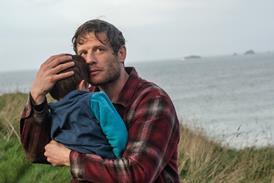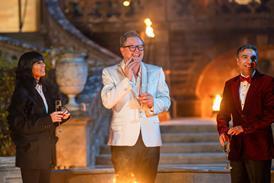Smithsonian’s programming chief talks about its UK ambitions and staying true to its founding principles
Smithsonian Channel is returning to the birthplace of its parent institution’s founding nearly 200 years after British scientist James Smithson pledged his fortune to creating an American establishment aimed at “the increase and diffusion of knowledge among men”.
That mantra has been the aspiration for Smithsonian’s US cable channel since its launch in 2007, and the venerable brand is now heading to the UK with similar goals.
As a channel in the unique position of being born out of a museum group – the Smithsonian Institute – the resources of which it uses to fact-check its programming slate, its execs believe it can meet a demand for trustworthy factual content.
The ambition is to deliver true factual of pedigree to fill a gap that some believe British unscripted channels have moved away from.

Speaking to Broadcast as the channel launches on Sky, Virgin, Freesat and Freeview, Smithsonian executive vice-president and chief programming officer David Royle says: “We are living in a world of false news, where people don’t know what to believe. They find reassurance in a channel like ours – we stand for credibility.”
Royle, a Brit who has been at the centre of US factual TV for two decades, is spearheading the UK expansion. He’s wasting no time preparing a second round of commissions, having already ordered six local programmes from UK indies before the channel’s launch on Tuesday 12 February.
The programming chief wants series and one-off specials that are either news-making or have strong British personalities at their heart.
Blink Films’ Mystic Britain, a 10-parter revealing the secrets of Britain’s most mysterious sites, is an example of the latter.
Original commissions will be a balance of shows purely for a UK audience and ones that speak directly to the UK audience, but can also travel back to the States. Tariffs will reflect international potential.
“The latter will rise up the list of programmes that are attractive to us,” says Royle.

His plans will be music to the ears of British indies. He is looking to debut at least one big UK original per quarter to sit alongside Smithsonian’s slate of US programmes, which include Aerial America, America In Colour and The Lost Tapes.
Smithsonian will also debut hour-long US documentaries The Green Book: Guide To Freedom and Pocahontas: The True Story. The latter has been re-edited with a new scene shot at St. George’s Church in Kent, where the remains of Pocahontas were found – again reflecting Britain’s role in history.
UK ambitions
In a similar vein, Smithsonian is in production on a series with Julie Montagu, an American who will give her take on the British aristocracy, having married the heir to the Earl of Sandwich.
“We are very determined that this is not just going to be a channel that is brought in from abroad,” says Royle. “It is going to be one that really embraces the UK and works extensively with UK production companies.”
Smithsonian is also challenging indies to find existing formats within the channel’s catalogue that could be given a British twist. “We want UK indies to be thinking about what this channel could be,” he adds.
Royle has already commissioned a one-off special of the Aerial America series, which will explore the natural wonders and ancient ruins of Ireland; a special episode of Air Warriors on the Spitfire; and a one-part follow-up to The Lost Tapes: Malcolm X, tracing the activist’s friendship with British Marxist Tariq Ali.
When Tariq Met Malcolm is being produced by TVT Productions and will debut on 21 February alongside the episode of The Lost Tapes.

A slate of specials to mark events such as the 50th anniversary of the moon landing are also being prepared, and the channel has bought first-window UK rights to Plimsoll Productions’ character-led docu-soap Big Cat Country, which takes a deep-dive look at three dynasties of lions in Zambia’s Luangwa Valley.
The series was commissioned by Love Nature, the factual-themed on-demand and linear channel that Smithsonian and Blue Ant Media have been rolling out internationally since 2015. Love Nature will be taking the second window in the UK for its Virgin Media channel.
Overall, Smithsonian UK will adopt a similar model to the US, where around 70% of its schedule is original versus 30% acquired.
The UK launch on key pay- and free-TV services will be Smithsonian Channel’s biggest to date, with a total reach of 19 million homes. The network first debuted in the US as a joint venture between CBS’s Showtime Networks and the Smithsonian Institute in 2007 in 150,000 homes and has grown its reach to 40 million homes in 12 years.
“We are very good at being rather late to the party but having a good time when we get there,” says Royle.
It will launch for the first time as a free service, which Royle says is in response to the dominance of free TV in the UK versus other markets.
DAVID ROYLE ON…
FAKE NEWS
We are living in a world of false news where people don’t know what to believe. They find reassurance in a channel like ours – we stand for credibility.
SMITHSONIAN’S GROWTH
We are very good at being rather late to the party but having a good time when we get there.
COMING TO THE UK
We know our programming works in the UK because a lot of it has already been shown on UK channels.
FACTUAL OPPORTUNITY
A lot of the so-called nonfiction channels have left behind good, solid factual programming to move into reality and even drama. Filling that gap has worked well for us.
INTERNATIONAL EXPANSION
When we come over, we are not just bringing a channel but also connections with the museum, research and the scientific world.
The network expanded into the Canadian market in 2013, followed by a Singapore launch in 2016 and a Latin American channel in May last year. After the UK debut, Smithsonian channels will roll out across Asia-Pacific, Turkey, Israel, the Middle East and Africa, and will be operated by Toronto-headquartered Blue Ant.
The network’s recently launched $5 (£3.90)-per-month SVoD service, Smithsonian Channel Plus, will not initially be included in the UK launch, but it has weaved on-demand rights into contracts to allow it the option in the future.
Smithsonian Channel Plus supersedes the company’s previous $3.99 (£3)-per-month SVoD service Smithsonian Earth, geared around nature and wildlife.

Royle acknowledges the competitiveness of the UK market, but says Smithsonian’s history of working with UK producers and broadcasters gives it a running start. “We know our programming works in the UK because a lot of it has already been shown on UK channels,” he adds.
The channel will join a vibrant factual market, which includes BBC4, PBS America, H2, Quest and National Geographic. “We have set a target that we are going to compete with channels that are a lot larger than we are,” says Royle.
Meanwhile, the US channel will continue to invest in co-productions with the UK’s PSBs for which it does not have UK rights, such as BBC2’s three-part series Inside Europe: 10 Years Of Turmoil.
“We would love in the future to do programmes like that and have a second window, but that won’t always be possible,” Royle acknowledges.
That may be so, but there’s still plenty of opportunity for indies who welcome Smithsonian into the country.
FILLING THE FACTUAL GAP
David Royle says the story of the Smithsonian Institution’s founding “is at the heart of who we are”. He places the success of its international expansion – becoming one of the most popular factual channels on DirecTV shortly after its launch in Latin America – to a broader dial-back in true factual.
“A lot of the so-called nonfiction channels have left behind good, solid factual programming to move into reality and even drama,” Royle says. “Filling that gap has worked well for us.”
PROMOTING CONTENT
Smithsonian Channel’s original content spans history, travel, air and space, science, nature and pop culture. To further tie the channel to the institution that founded it, Smithsonian plans to stage events to showcase the content of its programmes, similar to an 18-city tour of the US to promote its Green Book documentary.
“I’d like to think that is something we will bring to the UK market – where we have a project or film and can think of innovative ways to get it out into different communities,” says Royle.
“When we come over, we are not just bringing a channel but also connections with the museum, research and the scientific world,” he adds.






























No comments yet